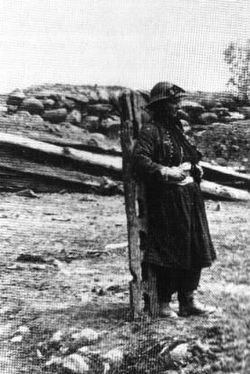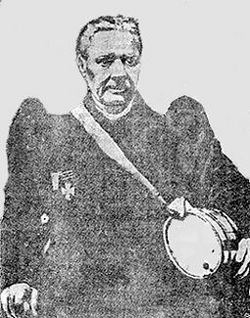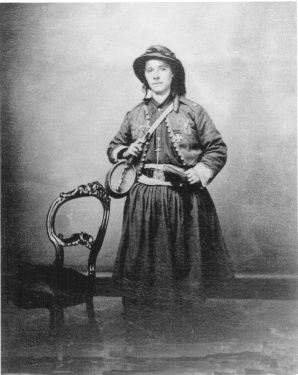Difference between revisions of "Marie Brose Tepe"
| Line 4: | Line 4: | ||
[[Image:Marie Brose.jpg]] | [[Image:Marie Brose.jpg]] | ||
| − | + | Library of Congress | |
| − | + | ||
| − | + | ||
| − | + | ||
"Hers was the only face in the vicinity which seemed in any way gay. She was laughing and pointing very unconcernedly, as she stumbled over axes, spades and other obstacles, on her way through the trench! She was wonderfully courageous or else did not understand the danger . . . the shower of musket-balls, shrapnel, and every sort of projectile falling in the midst of us was trying to the nerves of our coolest." | "Hers was the only face in the vicinity which seemed in any way gay. She was laughing and pointing very unconcernedly, as she stumbled over axes, spades and other obstacles, on her way through the trench! She was wonderfully courageous or else did not understand the danger . . . the shower of musket-balls, shrapnel, and every sort of projectile falling in the midst of us was trying to the nerves of our coolest." | ||
| Line 37: | Line 34: | ||
| − | + | [[File:Mary tepe 2.jpg|250px]] | |
| − | + | ||
From Military Images (March-April 1982): 18 | From Military Images (March-April 1982): 18 | ||
| Line 51: | Line 47: | ||
| − | + | [[File:Mary tepe 3.jpg|250px]] | |
| − | + | ||
From Military Images (July-August 1983): 15 | From Military Images (July-August 1983): 15 | ||
In 1897 Marie filed divorce papers, and in 1901 she wrote a will leaving all her possessions to her husband, valued at a total of $31.35. It was said that "for many years the aged woman had been an invalid and was lately a great sufferer from rheumatism and a rebel bullet which she still carrie[d] in her left ankle." After living alone for several years outside of Pittsburgh, the famous vivandiere of her youth took her own life in May of 1901 by drinking "paris green," a pesticide and paint pigment. | In 1897 Marie filed divorce papers, and in 1901 she wrote a will leaving all her possessions to her husband, valued at a total of $31.35. It was said that "for many years the aged woman had been an invalid and was lately a great sufferer from rheumatism and a rebel bullet which she still carrie[d] in her left ankle." After living alone for several years outside of Pittsburgh, the famous vivandiere of her youth took her own life in May of 1901 by drinking "paris green," a pesticide and paint pigment. | ||
| − | |||
| − | |||
| + | == Marie's grave had been unmarked for several decades, until in 1988 a stone was erected and then dedicated in a ceremony at St. Paul's Cemetery on Lafferty Hill in Carrick, Pennsylvania (a town outside of Pittsburgh): == | ||
| − | + | [[Image:Marie Brose Headstone.jpg|250px]] | |
Courtesy of Mike Colosimo | Courtesy of Mike Colosimo | ||
Latest revision as of 20:02, 24 April 2011
Marie Brose Tepe "French Mary" was a Civil War Veteran who moved to Carrick and was buried in Lafferty Hill Cemetery.
Internet Link to Marie Brose Tempe
"Hers was the only face in the vicinity which seemed in any way gay. She was laughing and pointing very unconcernedly, as she stumbled over axes, spades and other obstacles, on her way through the trench! She was wonderfully courageous or else did not understand the danger . . . the shower of musket-balls, shrapnel, and every sort of projectile falling in the midst of us was trying to the nerves of our coolest." (Frank Rauscher, Band Leader of the 114th PA)
Marie Brose was born on August 24, 1834 in the village of Brest, France. Her mother was French and her father Turkish. After the death of her father when she was about 10 years old, young Marie immigrated to the United States. Around the age of 20, she married Philadelphia tailor, Bernardo Tepe (also noted as Tebe).
At the start of the Civil War, Bernardo enlisted in Company I, 27th Pennsylvania Volunteers. He desired for his wife to stay home and manage their small tailor shop, but Marie refused to stay behind. She was determined to go with him, and at the age of 27, she decided to follow his regiment as a vivandiere.
Sometime before the end of 1861, Marie left her husband and the 27th PA. One veteran gave this reason: "One night some soldiers, among whom was her husband, broke into the vivandiere's tent and stole $1,600. The men were afterwards punished, but the vivandiere decided to quit the regiment. She refused to have anything to do with her husband. . . [She was] requested to continue with the regiment, but her indignation was so great that she left."
During the following year Marie somehow managed to join the 114th Pennsylvania, also known as Collis' Zouaves. It was with this regiment that she adopted her famous vivandiere uniform:
"Her uniform was similar to that of the women who followed the eagles of France. She wore a blue zouave jacket, a short skirt trimmed with red braid, which reached to just below the knees, and red trousers over a pair of boots. She wore a man's sailor hat turned down. She purchased a store of tobacco, cigars, hams and other things not issued by the government and sold them to the soldiers. She also did a thriving trade selling contraband whiskey. She carried the whiskey in a small oval keg strapped to her shoulder. When the regiment was not in action, she cooked, washed, mended for the men. She drew the pay of a soldier and was allowed 25 cents per day extra for hospital and headquarters services, making her pay $21.45 per month for over two years. Then some friction in the Paymaster's Department about the enlistment of women stopped her pay, but did not dampen her patriotism. She continued selling goods to the soldiers and $5 per pint for whiskey was not an unusual price."
Marie was undoubtedly an enterprising woman, and she had a knack for overcoming obstacles. On October 27, 1862, a member of the 114th witnessed Marie at a difficult fording of the Potomac River. He wrote: "All were in the same predicament, excepting the staff officers, who were on horseback, and Marie, the vivandiere, who had the forethought to pick up an old mule, on which she safely crossed the river."
On December 13, 1862, at the Battle of Fredericksburg, Marie was noted again: "Here, with the surgeons and Marie, the vivandiere, we established the field hospital, and soon after we had quite a number of our regiment, who were wounded, to assist in taking care of." However, at this same battle, "she received a bullet in her left ankle." It has been said that after this battle she received a silver cup presented to her by Lt. Col. Cavada and inscribed with the words: "To Marie, for noble conduct on the field of battle." She also received a letter (dated December 21, 1862) from Col. Collis thanking her for her bravery at Fredericksburg.
Marie was seen again at the Battle of Chancellorsville (May 3, 1863). A female nurse from Maine wrote: "[S]ince I left . . . for the hospital at Chancellorsville, I had not seen a woman, and I did not know that any other woman crossed the [Rappahannock] river at this place . . . excepting 'Mary,' the vivandiere of the 114th P.V., who was a brave and faithful worker."
After this battle Marie received the "Kearny Cross" for helping to organize one of the field hospitals. A member of the 114th said about the event: "We were pleased to find that quite a number of the valiant comrades of our regiment had received medals for meritorious conduct in battle, . . . Even Marie, the vivandiere, received one, but she would not wear it, remarking that General Birney could keep it, as she did not want the present. . . She was a courageous woman, and often got within range of the enemy's fire whilst parting with the contents of her canteen among our wounded men. Her skirts were riddled by bullets during the battle of Chancellorsville."
Once again, Marie was with her regiment in the campaign up to Gettysburg. One soldier wrote: "One June 12th [1863] the entire 3rd Corps passed us and . . . a good opportunity was had for watching this command pass in review. . . On foot and marching with the One Hundred and Fourteenth Pennsylvania (Collis' Zouaves) we saw 'French Mary.'" For several weeks following the Battle, she volunteered her services as a nurse in the field hospital located on Taneytown Road, behind the "Round Tops." At some point during this time, she was photographed on East Cemetery Hill:
 From Military Images (March-April 1982): 18
From Military Images (March-April 1982): 18
Marie was back with her regiment in winter quarters, and she was seen at Brandy Station, Virginia. At the time a member of the 114th remarked that "gambling was rife in the army, . . . and even our Marie, the cantiniere, was tempted to try her luck . . . but instead of winning, Marie soon lost, and was fifty dollars poorer by reason of her experience. She was too sharp to be caught again, and being thoroughly disgusted she played no more."
In the Spring of 1864 Marie was seen at the Bloody Angle during Spotsylvania by a soldier from another regiment. "I looked around," he wrote. "Sure enough there was a woman! She was about 25 years of age, square featured and sunburnt, and dressed in Zouave uniform in the Vivandiere style. She was with two men and they seemed to be looking for their regiment, the 114th Pennsylvania Infantry."
It is believed that Marie Tepe was still with the 114th in Washington, D.C. for the Grand Review held on May 23, 1865, followed by the mustering out of the regiment a few days later.
After the War, Marie moved to the Pittsburgh area and married Richard Leonard, a veteran of Company K, 1st Maryland Cavalry. Their date of marriage was April 9, 1872. In 1893 she travelled to Philadelphia to celebrate the anniversary of the Battle of Fredericksburg. She had a photograph taken at the reunion wearing her "Kearny Cross" and holding the same keg she carried during the War:
 From Military Images (July-August 1983): 15
From Military Images (July-August 1983): 15
In 1897 Marie filed divorce papers, and in 1901 she wrote a will leaving all her possessions to her husband, valued at a total of $31.35. It was said that "for many years the aged woman had been an invalid and was lately a great sufferer from rheumatism and a rebel bullet which she still carrie[d] in her left ankle." After living alone for several years outside of Pittsburgh, the famous vivandiere of her youth took her own life in May of 1901 by drinking "paris green," a pesticide and paint pigment.

